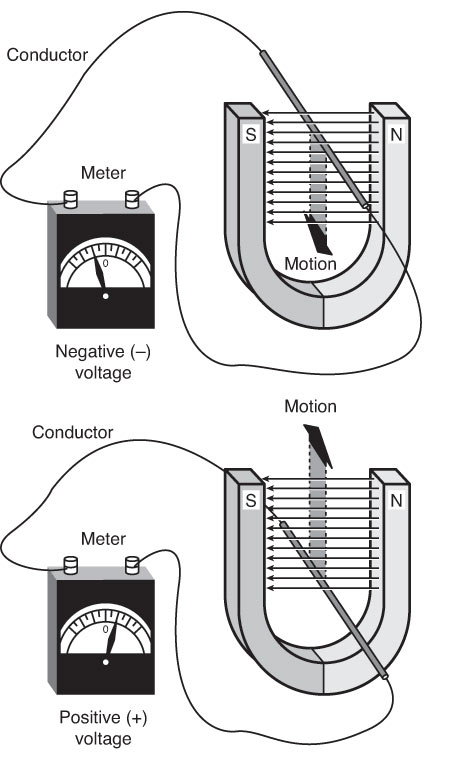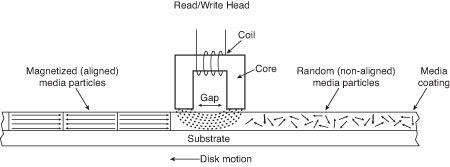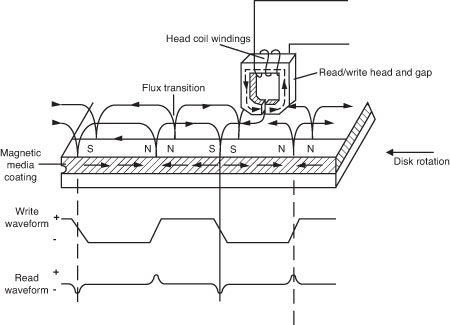Sponsored by QUE Publishing
Hard Drives 101: Magnetic Storage
Electromagnetism, Meet Data
Tom's Hardware and Que Publishing are partnering up to give you four chapters from Scott Mueller's Upgrading And Repairing PCs, 20th Edition. We're also giving away copies of the book to 10 lucky Tom's Hardware readers. To enter, please fill out the contest form, and remember that you can only enter once (if you entered last week when we published Computer History 101, we already have your entry).
This second chapter we're making available from Scott's book covers the ABCs of magnetic storage. Don't forget to check out the previous chapter published on Tom's Hardware, Computer History 101: The Development Of The PC. In the days to come, we'll also present comprehensive looks at Local Area Networking and Power Supplies.
Most permanent or semipermanent computer data is stored magnetically, meaning a stream of binary computer data bits (0s and 1s) is stored by magnetizing tiny pieces of metal embedded on the surface of a disk or tape in a pattern that represents the data. Later, this magnetic pattern can be read and converted back into the same original stream of bits. This is the principle of magnetic storage and the subject of this chapter.
History of Magnetic Storage
Before magnetic storage, the primary computer storage medium was punch cards (paper cards with holes punched in them to indicate character or binary data), originally invented by Herman Hollerith for use in the 1890 Census.
The history of magnetic storage dates back to June 1949, when a group of IBM engineers and scientists began working on a new storage device. What they were working on was the first magnetic storage device for computers, and it revolutionized the industry. On May 21, 1952, IBM announced the IBM 726 Tape Unit with the IBM 701 Defense Calculator, marking the transition from punched-card calculators to electronic computers.
Four years later, on September 13, 1956, a small team of IBM engineers in San Jose, California, introduced the first computer disk storage system as part of the 305 RAMAC (Random Access Method of Accounting and Control) computer.
The 305 RAMAC drive could store 5 million characters (that’s right, only 5 MB!) of data on 50 disks, each a whopping 24 inches in diameter. Individual bits were stored at a density of only 2 Kb/sq. inch. Unlike tape drives, RAMAC’s recording heads could go directly to any location on a disk surface without reading all the information in between. This random accessibility had a profound effect on computer performance at the time, enabling data to be stored and retrieved significantly faster than if it were on tape.
From these beginnings, in just over 60 years the magnetic storage industry has progressed such that today you can store 3 TB (3000 GB) or more on tiny 3 1/2-inch drives that fit into a single computer drive bay.
How Magnetic Fields Are Used to Store Data
All magnetic storage devices read and write data by using electromagnetism. This basic principle of physics states that as an electric current flows through a conductor (wire), a magnetic field is generated around the conductor (see Figure 8.1). Note that electrons actually flow from negative to positive, as shown in the figure, although we normally think of current flowing in the other direction.
Electromagnetism was discovered in 1819 by Danish physicist Hans Christian Oersted, when he found that a compass needle would deflect away from pointing north when brought near a wire conducting an electric current. When the current was shut off, the compass needle resumed its alignment with the Earth’s magnetic field and again pointed north.
The magnetic field generated by a wire conductor can exert an influence on magnetic material in the field. When the direction of the flow of electric current or polarity is reversed, the magnetic field’s polarity also is reversed. For example, an electric motor uses electromagnetism to exert pushing and pulling forces on magnets attached to a rotating shaft.
Another effect of electromagnetism was discovered by Michael Faraday in 1831. He found that if a conductor is passed through a moving magnetic field, an electrical current is generated. As the polarity of the magnetic field changes, so does the direction of the electric current’s flow (see Figure 8.2).
For example, an alternator, which is a type of electrical generator used in automobiles, operates by rotating electromagnets on a shaft past coils of stationary wire conductors, which consequently generates large amounts of electrical current in those conductors. Because electromagnetism works two ways, a motor can become a generator, and vice versa. When applied to magnetic storage devices, this two-way operation of electromagnetism makes it possible to record data on a disk and read that data back later. When recording, the head changes electrical impulses to magnetic fields, and when reading, the head changes magnetic fields back into electrical impulses.
The read/write heads in a magnetic storage device are U-shaped pieces of conductive material, with the ends of the U situated directly above (or next to) the surface of the actual data storage medium. The U-shaped head is wrapped with coils or windings of conductive wire, through which an electric current can flow (see the figure below). When the drive logic passes a current through these coils, it generates a magnetic field in the drive head. Reversing the polarity of the electric current also causes the polarity of the generated field to change. In essence, the heads are electromagnets whose voltage can be switched in polarity quickly.
The disk or tape that constitutes the actual storage medium consists of some form of substrate material (such as Mylar for floppy disks, or aluminum or glass for hard disks) on which a layer of magnetizable material has been deposited. This material usually is a form of iron oxide with various other elements added. Each of the individual magnetic particles on the storage medium has its own magnetic field. When the medium is blank, the polarities of those magnetic fields are normally in a state of random disarray. Because the fields of the individual particles point in random directions, each tiny magnetic field is canceled out by one that points in the opposite direction; the cumulative effect of this is a surface with no observable field polarity. With many randomly oriented fields, the net effect is no observable unified field or polarity.
When a drive’s read/write head generates a magnetic field (as when writing to a disk), the field jumps the gap between the ends of the U shape. Because a magnetic field passes through a conductor much more easily than through the air, the field bends outward from the gap in the head and actually uses the adjacent storage medium as the path of least resistance to the other side of the gap. As the field passes through the medium directly under the gap, it polarizes the magnetic particles it passes through so they are aligned with the field. The field’s polarity or direction—and, therefore, the polarity or direction of the field induced in the magnetic medium—is based on the direction of the flow of electric current through the coils. A change in the direction of the current flow produces a change in the direction of the magnetic field. During the development of magnetic storage, the distance between the read/write head and the media has decreased dramatically. This enables the gap to be smaller and makes the size of the recorded magnetic domain smaller. The smaller the recorded magnetic domain, the higher the density of data that can be stored on the drive.
When the magnetic field passes through the medium, the particles in the area below the head gap are aligned in the same direction as the field emanating from the gap. When the individual magnetic domains of the particles are in alignment, they no longer cancel one another out, and an observable magnetic field exists in that region of the medium. This local field is generated by the many magnetic particles that now are operating as a team to produce a detectable cumulative field with a unified direction.
The term flux describes a magnetic field that has a specific direction or polarity. As the surface of the medium moves under the drive head, the head can generate what is called a magnetic flux of a given polarity over a specific region of the medium. When the flow of electric current through the coils in the head is reversed, so is the magnetic field polarity or flux in the head gap. This flux reversal in the head causes the polarity of the magnetized particles on the disk medium to reverse.
The flux reversal (or flux transition) is a change in the polarity of the aligned magnetic particles on the surface of the storage medium. A drive head creates flux reversals on the medium to record data. For each data bit (or bits) that a drive writes, it creates a pattern of positive-to-negative and negative-to-positive flux reversals on the medium in specific areas known as bit cells or transition cells. A bit cell or transition cell is a specific area of the medium—controlled by the time and speed at which the medium travels—in which the drive head creates flux reversals. The particular pattern of flux reversals within the transition cells used to store a given data bit (or bits) is called the encoding method. The drive logic or controller takes the data to be stored and encodes it as a series of flux reversals over a period of time, according to the pattern dictated by the encoding method it uses.
Note: The two most popular encoding methods for magnetic media are Modified Frequency Modulation (MFM) and Run Length Limited (RLL). All floppy disk drives and some older hard disk drives use the MFM scheme. Today’s hard disk drives use one of several variations on the RLL encoding method. These encoding methods are described in more detail later in this chapter in the section “Data-Encoding Schemes.”
During the write process, voltage is applied to the head. As the polarity of this voltage changes, the polarity of the magnetic field being recorded also changes. The flux transitions are written precisely at the points where the recording polarity changes. Strange as it might seem, during the read process, a head does not generate exactly the same signal that was written. Instead, the head generates a voltage pulse or spike only when it crosses a flux transition. When the transition changes from positive to negative, the pulse that the head detects is a negative voltage. When the transition changes from negative to positive, the pulse is a positive voltage spike. This effect occurs because current is generated in a conductor only when passing through lines of magnetic force at an angle. Because the head moves parallel to the magnetic fields it created on the media, the only time the head generates voltage when reading is when passing through a polarity or flux transition (flux reversal).
In essence, while reading from the medium, the head becomes a flux transition detector, emitting voltage pulses whenever it crosses a transition. Areas of no transition generate no pulse. Figure 8.4 shows the relationship between the read and write waveforms and the flux transitions recorded on a storage medium.
You can think of the write pattern as being a square waveform that is at a positive or negative voltage level. When the voltage is positive, a field is generated in the head, which polarizes the magnetic media in one direction. When the voltage changes to negative, the magnetic field induced in the media also changes direction. Where the waveform actually transitions from positive to negative voltage, or vice versa, the magnetic flux on the disk also changes polarity. During a read, the head senses these flux transitions and generates a pulsed positive or negative waveform, rather than the continuously positive or negative waveform used during the original recording. In other words, the signal when reading is 0 volts unless the head detects a magnetic flux transition, in which case it generates a positive or negative pulse accordingly. Pulses appear only when the head is passing over flux transitions on the medium. By knowing the clock timing the drive uses, the controller circuitry can determine whether a pulse (and therefore a flux transition) falls within a given transition cell time period.
The electrical pulse currents generated in the head while it is passing over the storage medium in read mode are weak and can contain significant noise. Sensitive electronics in the drive and controller assembly amplify the signal above the noise level and decode the train of weak pulse currents back into binary data that is (theoretically) identical to the data originally recorded.
As you can see, hard disk drives and other storage devices read and write data by means of basic electromagnetic principles. A drive writes data by passing electrical currents through an electromagnet (the drive head), generating a magnetic field that is stored on the medium. The drive reads data by passing the head back over the surface of the medium. As the head encounters changes in the stored magnetic field, it generates a weak electrical current that indicates the presence or absence of flux transitions in the signal as it was originally written.
Current page: Electromagnetism, Meet Data
Next Page Read/Write Head Designs: Ferrite, Metal-In-Gap, And Thin-FilmGet Tom's Hardware's best news and in-depth reviews, straight to your inbox.
Tom's Hardware is the leading destination for hardcore computer enthusiasts. We cover everything from processors to 3D printers, single-board computers, SSDs and high-end gaming rigs, empowering readers to make the most of the tech they love, keep up on the latest developments and buy the right gear. Our staff has more than 100 years of combined experience covering news, solving tech problems and reviewing components and systems.
-
soccerdocks "Density initially grew at a rate of about 25% per year (doubling every four years)"Reply
If density grows at 25% per year it would actually double in just barely over 3 years. At 4 years it would be 144% greater. -
joytech22 Replywhen passed over magnetic flux transitions.
I somehow expected "Flux capacitors" instead. -
johnners2981 soccerdocks"Density initially grew at a rate of about 25% per year (doubling every four years)"If density grows at 25% per year it would actually double in just barely over 3 years. At 4 years it would be 144% greater.Reply
No you're wrong, how embarrassing :). You're using compound interest. Quit trying to be a smartass -
Device Unknown johnners2981No you're wrong, how embarrassing . You're using compound interest. Quit trying to be a smartassReply
I'm no math guy, in fact i suck at it, but I see his point, why wouldn't it be compound? and even at compound interest is 144 still accurate? please enplane
-
soo-nah-mee I believe soccerdocks is right - example...Reply
Beginning value: 10
After one year: 12.5
After two years: 15.625
After three years: 19.531 (Almost double)
After four years: 24.41 -
johnners2981 Device UnknownI'm no math guy, in fact i suck at it, but I see his point, why wouldn't it be compound? and even at compound interest is 144 still accurate? please enplaneReply
Please enplane??? Compound interest is used to calculate interest and not things like density.
They were right in saying "doubling every four years" and he was trying to correct them when there was no need so showed him who's boss, oh yeah -
johnners2981 soo-nah-meeI believe soccerdocks is right - example...Beginning value: 10After one year: 12.5After two years: 15.625After three years: 19.531 (Almost double)After four years: 24.41Reply
His calculation is right not the application, why is he using compound interest to calculate the percentage increase in density? It doesn't make sense. -
soo-nah-mee johnners2981His calculation is right not the application, why is he using compound interest to calculate the percentage increase in density? It doesn't make sense.It's not compound "interest", but it is compounding. If you say something increases 25% each year, you can't just keep adding 25% of the original value! Silly.Reply
-
striker410 soo-nah-meeIt's not compound "interest", but it is compounding. If you say something increases 25% each year, you can't just keep adding 25% of the original value! Silly.I agree with the others on this one. Since it's adding 25% each year, it is compound. You are thinking of it from the wrong angle.Reply




